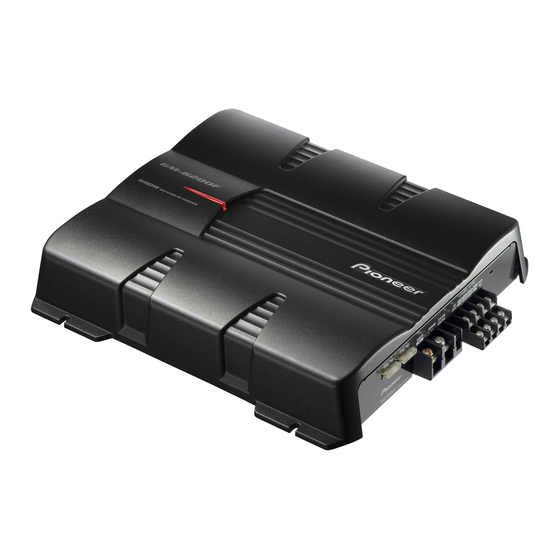Pioneer GM-6200F Benutzerhandbuch - Seite 5
Blättern Sie online oder laden Sie pdf Benutzerhandbuch für Verstärken Pioneer GM-6200F herunter. Pioneer GM-6200F 14 Seiten. Bridgeable four-channel power amplifier
Auch für Pioneer GM-6200F: Benutzerhandbuch (9 seiten), Service-Handbuch (33 seiten)

- 1. Before Using this Product
- 2. Information to User
- 3. Product Registration
- 4. Setting the Unit
- 5. Gain Control
- 6. Power Indicator
- 7. Input Select Switch
- 8. Connecting the Unit
- 9. Connection Diagram
- 10. Connecting the Power Terminal
- 11. Connecting the Speaker Output Terminals
- 12. Using the Speaker Input
- 13. Example of Installation on the Floor Mat or on the Chassis
- 14. Specifications
- 15. Average Current Drawn
- 16. Additional Information
Connecting the Unit
CAUTION
• Disconnect the negative (–) terminal of the battery
to avoid the risk of short-circuit and damage to
the unit.
• Secure the wiring with cable clamps or adhesive
tape. To protect the wiring, wrap adhesive tape
around it where they lie against metal parts.
• Do not route wires where they will get hot, for
example where the heater will blow over them. If
the insulation heats up, it may become damaged,
resulting in a short-circuit through the vehicle
body.
CAUTION:
To prevent damage and/or injury
• Do not ground the speaker wire directly or con-
nect a negative (–) lead wire for several speakers.
• This unit is for vehicles with a 12-volt battery and
negative grounding. Before installing it in a recre-
ational vehicle, truck or bus, check the battery
voltage.
• If the car stereo is kept on for a long time while
the engine is at rest or idling, the battery may go
dead. Turn the car stereo off when the engine is at
rest or idling.
• If the system remote control wire of the amplifier
is connected to the power terminal through the
ignition switch (12 V DC), the amplifier will
always be on when the ignition is on— regardless
of whether the car stereo is on or off. Because of
this, the battery could go dead if the engine is at
rest or idling.
Speaker Channel
Four-channel
Two-channel
Three-channel
Speaker output A
Three-channel
Speaker output B
• Make sure that wires will not interfere with mov-
• Do not shorten any wires. Otherwise the protec-
• Never feed power to other equipment by cutting
• Never replace the fuse with one of greater value
• Speakers to be connected to the amplifier should
• Install and route the separately sold battery wire
• Cords for this product and those for other prod-
Speaker Type
Subwoofer
Other than subwoofer
Subwoofer
Other than subwoofer
Subwoofer
Other than subwoofer
Subwoofer
Other than subwoofer
ing parts of the vehicle, such as the gearshift,
handbrake or seat sliding mechanism.
tion circuit may fail to work when it should.
the insulation of the power supply wire to tap
from the wire. The current capacity of the wire
will be exceeded, causing overheating.
or rating than the original fuse. Use of an improp-
er fuse could result in overheating and smoke and
could cause damage to the product and injury
including burns.
conform with the standards listed below. If they
do not conform, they may catch fire, emit smoke
or become damaged. The speaker impedance must
be 2 to 8 ohms. But in case of two-channel and
other bridge connections, the speaker impedance
must be 4 to 8 ohms.
as far away as possible from the speaker wires.
Install and route the separately sold battery wire,
ground wire, speaker wires and the amplifier as
far away as possible from the antenna, antenna
cable and tuner.
ucts may be different colors even if they have the
same function. When connecting this product to
another product, refer to the supplied Installation
manuals of both products and connect cords that
have the same function.
Power
Nominal input: Min. 70 W
Max. input: Min. 120 W
Nominal input: Min. 200 W
Max. input: Min. 300 W
Nominal input: Min. 70 W
Max. input: Min. 120 W
Nominal input: Min. 200 W
Max. input: Min. 300 W
